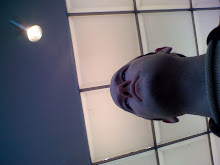I'm back! Firstly, I'd like to say 'thank you' to the many people (worldwide) who have shown interest and enthusiasm for DigitURL in these initial few months. It has been reaffirming for me in my belief that the DigitURL concept is valid and could be a success. It will also encourage me to pursue more work on the site; I have many more features in mind! You are DigitURL 'early adopters', and that's special!
Now, onto the main topic of this post: 2D barcodes. Amongst other things, 2D barcodes can be used to facilitate web access on mobile phones. They make it much easier to enter URL information. You photograph the symbol with your phone's camera, a program extracts the code from the image, decodes it to a URL, which is then sent to your phone's browser. It's been huge in Japan for a few years, but it's yet to catch on elsewhere, for a variety of reasons. There's no doubt it's a cool idea, and it's dripping with tech geek goodness.
DigitURL is also a facilitator of web access on mobile phones. As with 2D barcodes, URL entry is simplified, but the phone keypad buttons are used as the data source rather than the phone's camera. The comparison of DigitURL and 2D barcodes as mobile web access facilitators is obvious, and I believe each has strong points. Various types of comparisons may be made (especially with regards to usability), and I have summarised a couple in a table:

A major advantage of DigitURLs is that they are very easily communicated. Unlike 2D barcodes, they can be communicated verbally, as well as using handwriting, typing and via texting. DigitURLs can also be memorised, and memorisation is particularly easy for several thousand of the most popular websites, which are accessible by pressing the keypad letters corresponding to the websites' names. 2D barcodes require the user to have the symbol physically placed in front of them; if it's not present, it can't be used. Communication typically requires transmission of a graphics file or the physical movement of computer-generated printed matter, e.g. a magazine.
Another advantage of DigitURLs is that they can be readily used on desktop computers. This is quite difficult to achieve with 2D barcodes.
Both types of code suffer from a lack of meaning to human readers. Even URLs often suffer from this. The codes of themselves don't give clues as to what they link to.
Major advantages of 2D barcodes are the great extent to which they simplify URL data entry to the phone, their mode of action (which can seem magical), and the novel and 'cool' appearance of the codes.
I believe the different codes each have roles to play and can complement each other. That's why I've just added DigitURL/2D barcode 'stickers' to the website. For any DigitURL result, you can get its sticker by clicking on its 'Sticker' link. The images can be printed for use in the 'real world', or hotlinked from other websites.
Each DigitURL/2D barcode sticker contains:
- A 2D barcode that encodes the original website URL.
- A DigitURL you can use to access the site.
- The website 'name' (only if the DigitURL numbers correspond, i.e. for popular sites).
- The original website URL.
Here is an example:

Let me know what you think!
Andy
 I'm pleased to announce the launch of my new website, FIRXT.com. Firxt is a search portal designed for mobile devices and supports OpenSearch and Sherlock search engine description plugins.
I'm pleased to announce the launch of my new website, FIRXT.com. Firxt is a search portal designed for mobile devices and supports OpenSearch and Sherlock search engine description plugins.
